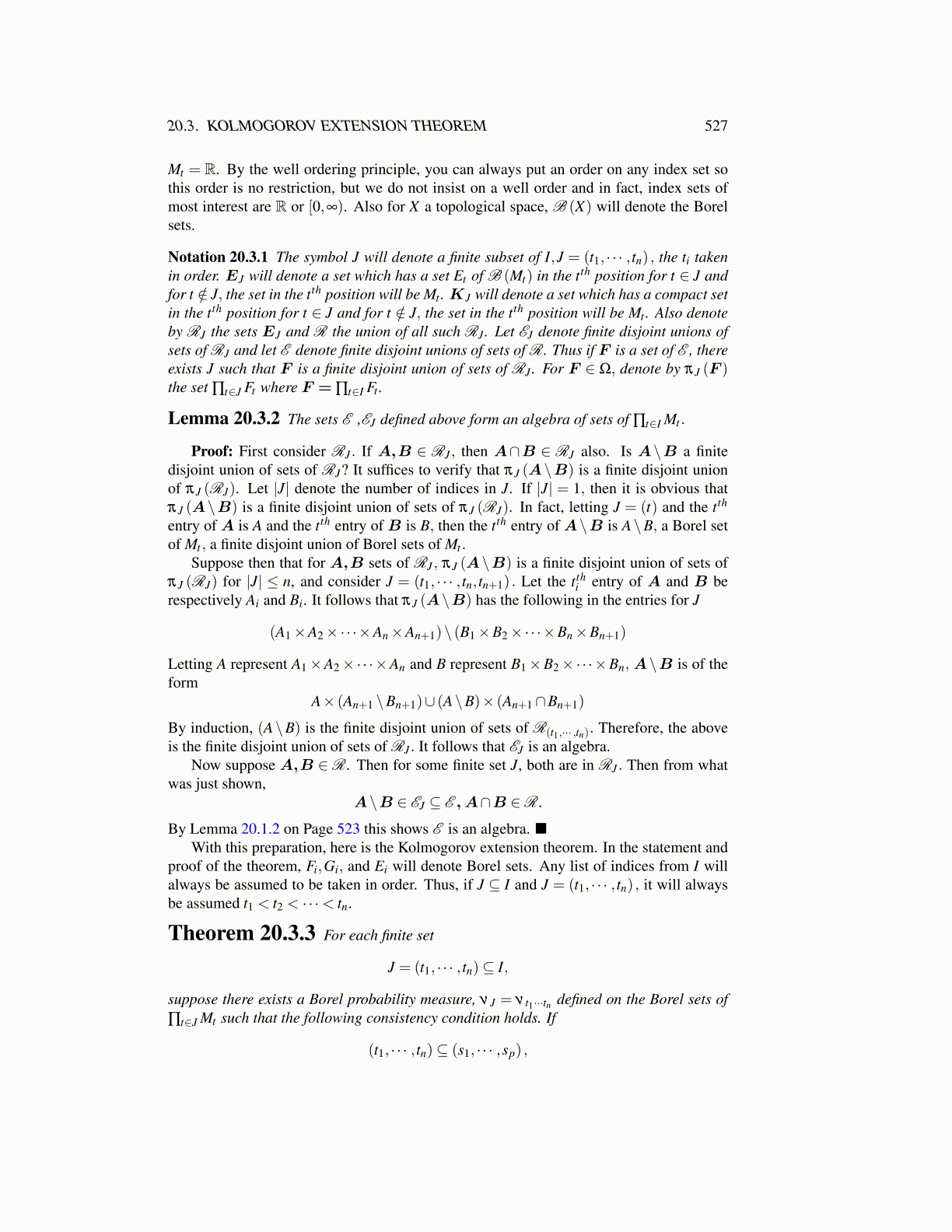
20.3. KOLMOGOROV EXTENSION THEOREM 527
Mt = R. By the well ordering principle, you can always put an order on any index set sothis order is no restriction, but we do not insist on a well order and in fact, index sets ofmost interest are R or [0,∞). Also for X a topological space, B (X) will denote the Borelsets.
Notation 20.3.1 The symbol J will denote a finite subset of I,J = (t1, · · · , tn) , the ti takenin order. EJ will denote a set which has a set Et of B (Mt) in the tth position for t ∈ J andfor t /∈ J, the set in the tth position will be Mt . KJ will denote a set which has a compact setin the tth position for t ∈ J and for t /∈ J, the set in the tth position will be Mt . Also denoteby RJ the sets EJ and R the union of all such RJ . Let EJ denote finite disjoint unions ofsets of RJ and let E denote finite disjoint unions of sets of R. Thus if F is a set of E , thereexists J such that F is a finite disjoint union of sets of RJ . For F ∈ Ω, denote by πJ (F )the set ∏t∈J Ft where F = ∏t∈I Ft .
Lemma 20.3.2 The sets E ,EJ defined above form an algebra of sets of ∏t∈I Mt .
Proof: First consider RJ . If A,B ∈ RJ , then A∩B ∈ RJ also. Is A\B a finitedisjoint union of sets of RJ? It suffices to verify that πJ (A\B) is a finite disjoint unionof πJ (RJ). Let |J| denote the number of indices in J. If |J| = 1, then it is obvious thatπJ (A\B) is a finite disjoint union of sets of πJ (RJ). In fact, letting J = (t) and the tth
entry of A is A and the tth entry of B is B, then the tth entry of A\B is A\B, a Borel setof Mt , a finite disjoint union of Borel sets of Mt .
Suppose then that for A,B sets of RJ , πJ (A\B) is a finite disjoint union of sets ofπJ (RJ) for |J| ≤ n, and consider J = (t1, · · · , tn, tn+1) . Let the tth
i entry of A and B berespectively Ai and Bi. It follows that πJ (A\B) has the following in the entries for J
(A1×A2×·· ·×An×An+1)\ (B1×B2×·· ·×Bn×Bn+1)
Letting A represent A1×A2×·· ·×An and B represent B1×B2×·· ·×Bn, A\B is of theform
A× (An+1 \Bn+1)∪ (A\B)× (An+1∩Bn+1)
By induction, (A\B) is the finite disjoint union of sets of R(t1,··· ,tn). Therefore, the aboveis the finite disjoint union of sets of RJ . It follows that EJ is an algebra.
Now suppose A,B ∈R. Then for some finite set J, both are in RJ . Then from whatwas just shown,
A\B ∈ EJ ⊆ E , A∩B ∈R.
By Lemma 20.1.2 on Page 523 this shows E is an algebra. ■With this preparation, here is the Kolmogorov extension theorem. In the statement and
proof of the theorem, Fi,Gi, and Ei will denote Borel sets. Any list of indices from I willalways be assumed to be taken in order. Thus, if J ⊆ I and J = (t1, · · · , tn) , it will alwaysbe assumed t1 < t2 < · · ·< tn.
Theorem 20.3.3 For each finite set
J = (t1, · · · , tn)⊆ I,
suppose there exists a Borel probability measure, νJ = ν t1···tn defined on the Borel sets of∏t∈J Mt such that the following consistency condition holds. If
(t1, · · · , tn)⊆ (s1, · · · ,sp) ,